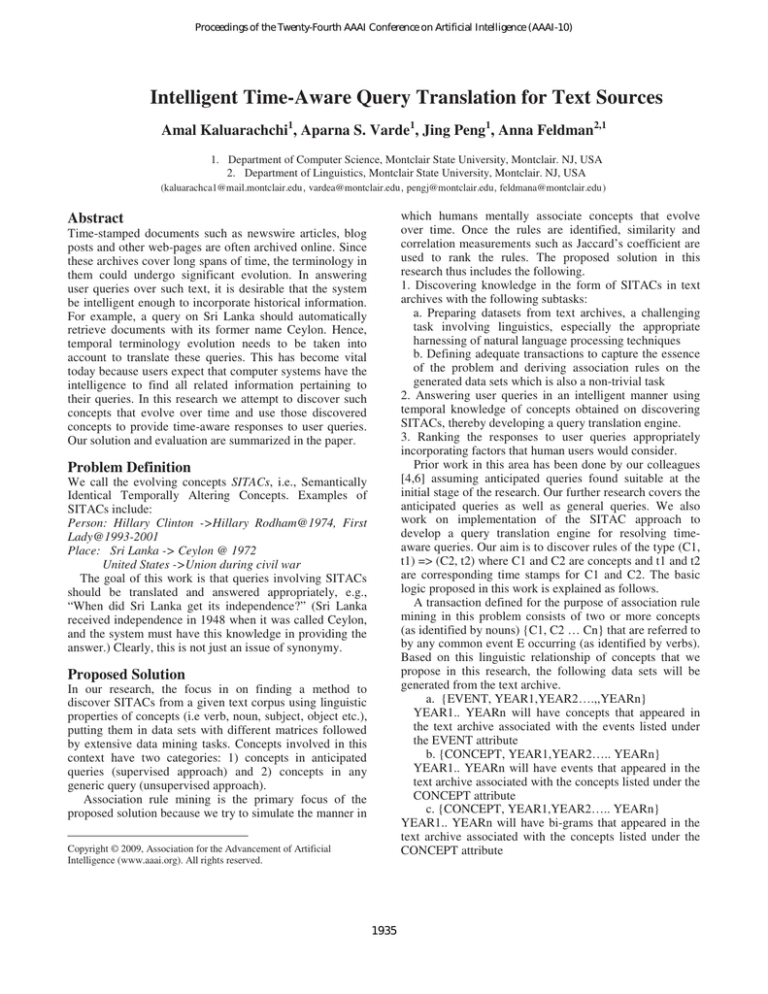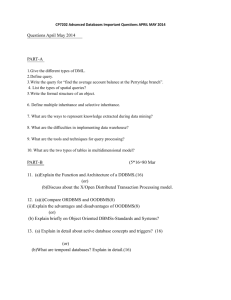
Proceedings of the Twenty-Fourth AAAI Conference on Artificial Intelligence (AAAI-10)
Intelligent Time-Aware Query Translation for Text Sources
Amal Kaluarachchi1, Aparna S. Varde1, Jing Peng1, Anna Feldman2,1
1. Department of Computer Science, Montclair State University, Montclair. NJ, USA
2. Department of Linguistics, Montclair State University, Montclair. NJ, USA
(kaluarachca1@mail.montclair.edu, vardea@montclair.edu, pengj@montclair.edu, feldmana@montclair.edu)
which humans mentally associate concepts that evolve
over time. Once the rules are identified, similarity and
correlation measurements such as Jaccard’s coefficient are
used to rank the rules. The proposed solution in this
research thus includes the following.
1. Discovering knowledge in the form of SITACs in text
archives with the following subtasks:
a. Preparing datasets from text archives, a challenging
task involving linguistics, especially the appropriate
harnessing of natural language processing techniques
b. Defining adequate transactions to capture the essence
of the problem and deriving association rules on the
generated data sets which is also a non-trivial task
2. Answering user queries in an intelligent manner using
temporal knowledge of concepts obtained on discovering
SITACs, thereby developing a query translation engine.
3. Ranking the responses to user queries appropriately
incorporating factors that human users would consider.
Prior work in this area has been done by our colleagues
[4,6] assuming anticipated queries found suitable at the
initial stage of the research. Our further research covers the
anticipated queries as well as general queries. We also
work on implementation of the SITAC approach to
develop a query translation engine for resolving timeaware queries. Our aim is to discover rules of the type (C1,
t1) => (C2, t2) where C1 and C2 are concepts and t1 and t2
are corresponding time stamps for C1 and C2. The basic
logic proposed in this work is explained as follows.
A transaction defined for the purpose of association rule
mining in this problem consists of two or more concepts
(as identified by nouns) {C1, C2 … Cn} that are referred to
by any common event E occurring (as identified by verbs).
Based on this linguistic relationship of concepts that we
propose in this research, the following data sets will be
generated from the text archive.
a. {EVENT, YEAR1,YEAR2….,,YEARn}
YEAR1.. YEARn will have concepts that appeared in
the text archive associated with the events listed under
the EVENT attribute
b. {CONCEPT, YEAR1,YEAR2….. YEARn}
YEAR1.. YEARn will have events that appeared in the
text archive associated with the concepts listed under the
CONCEPT attribute
c. {CONCEPT, YEAR1,YEAR2….. YEARn}
YEAR1.. YEARn will have bi-grams that appeared in the
text archive associated with the concepts listed under the
CONCEPT attribute
Abstract
Time-stamped documents such as newswire articles, blog
posts and other web-pages are often archived online. Since
these archives cover long spans of time, the terminology in
them could undergo significant evolution. In answering
user queries over such text, it is desirable that the system
be intelligent enough to incorporate historical information.
For example, a query on Sri Lanka should automatically
retrieve documents with its former name Ceylon. Hence,
temporal terminology evolution needs to be taken into
account to translate these queries. This has become vital
today because users expect that computer systems have the
intelligence to find all related information pertaining to
their queries. In this research we attempt to discover such
concepts that evolve over time and use those discovered
concepts to provide time-aware responses to user queries.
Our solution and evaluation are summarized in the paper.
Problem Definition
We call the evolving concepts SITACs, i.e., Semantically
Identical Temporally Altering Concepts. Examples of
SITACs include:
Person: Hillary Clinton ->Hillary Rodham@1974, First
Lady@1993-2001
Place: Sri Lanka -> Ceylon @ 1972
United States ->Union during civil war
The goal of this work is that queries involving SITACs
should be translated and answered appropriately, e.g.,
“When did Sri Lanka get its independence?” (Sri Lanka
received independence in 1948 when it was called Ceylon,
and the system must have this knowledge in providing the
answer.) Clearly, this is not just an issue of synonymy.
Proposed Solution
In our research, the focus in on finding a method to
discover SITACs from a given text corpus using linguistic
properties of concepts (i.e verb, noun, subject, object etc.),
putting them in data sets with different matrices followed
by extensive data mining tasks. Concepts involved in this
context have two categories: 1) concepts in anticipated
queries (supervised approach) and 2) concepts in any
generic query (unsupervised approach).
Association rule mining is the primary focus of the
proposed solution because we try to simulate the manner in
Copyright © 2009, Association for the Advancement of Artificial
Intelligence (www.aaai.org). All rights reserved.
1935
In this research we are interested in exploiting the
relationships in different part of speech. By doing that we
find events (verb) used by concepts (nouns).
In order to improve the quality of the results obtained
from mining the rules, we propose to rank the rules based
on the Jaccard’s coefficient for similarity. On studying the
literature, e.g., [6], this was found to be very effective in
capturing contextual similarity. In our problem, we deploy
this as follows. Consider that we have rules such as:
Union => USA and Union => EU
To apply Jaccard’s coefficient, we do the following, with
reference to Figure 1.
After ranking, we got a set of rules as summarized in the
sample shown in Figure 3. These rules were used to
populate a knowledge base consisting of SITACs to serve
as the basis for intelligent time-aware query translation.
W1=”accession”,
W6=”government”
W7=”blessed” and
there is long list of
words. (W1..Wn).
WordNet [7] provides correlated concepts but without the
temporal factor. We can use inputs from this for our
supervised approach with anticipated queries [4,6]. There
are contextual similarity measures such as SimRank [2],
named entity recognition methods, e.g., [1] and intertransaction associations on temporal document collections
as in [3]. We can draw an analogy here, though we make
an additional contribution in terms of intelligent query
processing by the discovery of semantically identical
temporally altering concepts for historical time-aware
query translation.
.
1. 1795=Union ==> 1958=United States
2. 1872= Union ==> 1995=United States
3. 1958= Nation ==> 1999= United States
4. 1995=work ==> 1999=teacher
5. 1895=Administration 1999=teacher ==> 1958=work
6. 1952=war ==> 1999=terrorist
7. 1952=war 1952= weapon ==> 1999=terrorist
Figure 3: Sample of Rules for Knowledge Base
Related Work
Figure 1: Using Jaccard’s coefficient for similarity
Based on this, Jaccard’s coefficient similarity score JS
can be calculated as follows.
JS(Union,USA) = (Union ∪ USA) / (Union ∩ USA)
Thus, JS (Union, USA) = 3/8 = 0.38,
and JS (Union, EU) = 2/8 = 0.33
We find that JS (Union, USA) > JS (Union, EU)
Thus, (Union, USA) has a higher rank than (Union, EU)
This final similarity scores of all SITACs derived from
association mining rules will be stored in a knowledge base
to resolve future queries.
Conclusions
The artificial intelligence contributions of this research are:
1. Identifying the problem of time-aware query translation
in text archives and defining SITACs with the goal of
intelligent query processing.
2. Proposing a methodology to discover the SITACs by
simulating human thinking based on an integration of
natural language processing and association rule mining
addressing its non-trivial subtasks.
3. Ranking the SITACs exploiting linguistic properties and
Jaccard’s coefficient and developing a knowledge base of
ranked SITACs to serve as the basis for answering user
queries in an intelligent manner.
Experimental Evaluation
We summarize our experimental evaluation using the
Gutenberg corpus with the USA presidential speeches. We
preprocessed this data using a Java program developed by
us and sub documents were generated based on the time
they were produced. Those set of documents were
syntactically parsed with Minipar (References) to obtain
the transactions as we defined. Figure 2 shows a sample
output from the Minipar parser used in our work.
Acknowledgements
We thank Srikanta Bedathur and Gerhard Weikum from the Max
Planck Institute for Informatics, Germany and. Debjani Roy from
Computer Science at Montclair State University for their inputs.
References
[1] Hasegawa, T., Sekine S.,Grishman R., “Discovering Relations among
Named Entities from Large Corpora”,ACL (Aug 2004), pp. 415-422.
[2] Jeh., G., Widom., J.: ”SimRank: A Measure of Structural-Context
Similarity”. KDD (Jul 2002), pp. 538–543.
[3] Norvag, K., Eriksen, T.O. , Skogstad, K.I : ”Mining Association Rules
in Temporal Document Collections”, Dept. of Computer and Information,
Systems (2006), NTNU, Norway.
[4] Roychoudhury D.., Varde A., “Terminology Evolution in Web and
Text Mining Using Association Rules”, Dept. of Computer Science (May
2009), Montclair State University, NJ.
[5] Strehl A. Ghosh, J. and Mooney R.: “Impact of Similarity Measures
on Web-page Clustering”, AAAI, (Jul 2000), pp. 58-64.
[6] Varde A., Bedathur S., Berberich K, Weikum G., “Time Aware Query
Translation over Text Archives”, Max Planck Institute for Informatics
(Jul 2008), Saarbrucken, Germany.
[7] WordNet http://wordnetweb.princeton.edu/perl/webwn
Figure 2 : Partial Snapshot of Parsing
Then we programmatically analyzed the output from
Minipar to generate datasets which were used as the input
to the widely-used data mining tool WEKA, i.e., the
Waikato Environment for Knowledge Analysis, which
includes the code for implementing the Apriori algorithm
for association rule mining. The rules obtained were
subject to ranking using the method we described.
1936





